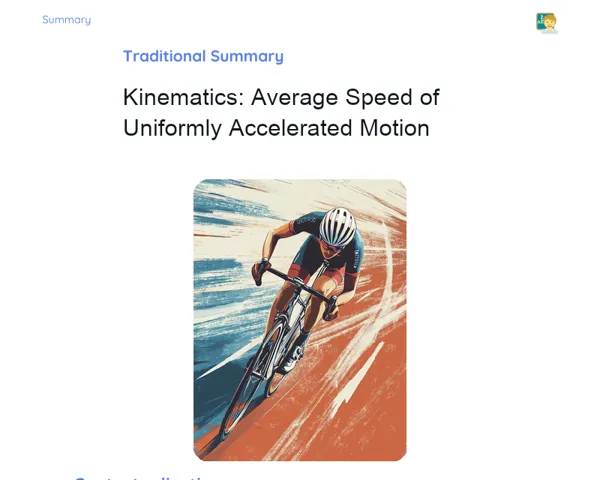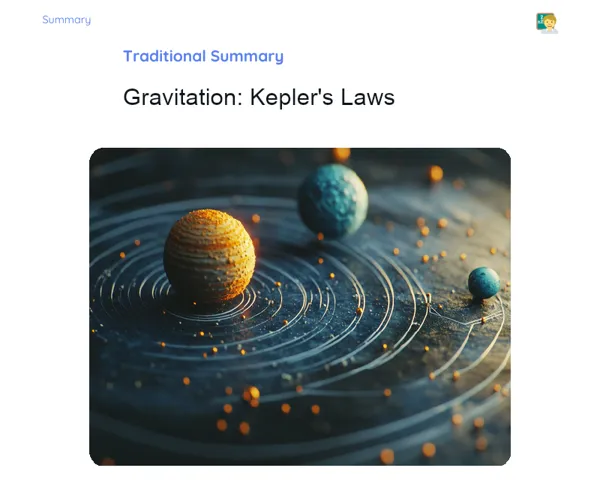Summary Tradisional | Momentum and Impulse: Two-Dimensional Collisions
Contextualization
When we delve into the study of collisions in physics, understanding the concepts of impulse and momentum is crucial for grasping how objects interact during an impact. Impulse refers to the change in momentum resulting from a force applied over a certain duration. On the other hand, momentum is the net product of an object’s mass and its velocity. These ideas are key to understanding collision dynamics, especially in two-dimensional scenarios, where we must assess the vector components separately.
The conservation of momentum is a core law in physics that asserts that in an isolated system, the total momentum remains unchanged before and after a collision. This principle applies to both elastic collisions, where kinetic energy is retained, and inelastic collisions, where some kinetic energy is converted into other energy forms. Additionally, the coefficient of restitution gauges the elasticity of a collision, aiding in predicting how bodies behave post-impact. These concepts hold substantial significance not just in academia but also in practical situations, such as analyzing road accidents and designing safety features.
To Remember!
Impulse
Impulse is a basic yet crucial concept in physics, defined as the change in momentum of an object due to an applied force over a time interval. The basic formula for impulse is I = F * Δt, where I denotes impulse, F is the force exerted, and Δt is the duration of the force application. This relationship illustrates that impulse relies on both the strength of the force and the time it is applied.
An important attribute of impulse is that it is a vector quantity, which means it has both direction and magnitude. This becomes essential during two-dimensional collisions, as impulse must be evaluated separately in both the x and y directions. For instance, if a force is exerted at an angle, the impulse will have components in both directions that must be analyzed independently.
Impulse finds wide application in various fields of physics and engineering. For instance, during car accidents, understanding impulse is vital in analyzing how impact forces spread over time, which is crucial for developing safety measures like airbags and energy-absorbing structures.
-
Impulse represents the change in momentum due to an applied force over a specified time interval.
-
Impulse is a vector quantity characterized by both direction and magnitude.
-
Understanding impulse is key to analyzing collisions and designing vehicle safety systems.
Momentum
Momentum, commonly referred to as linear momentum, is defined as the product of an object's mass and its velocity. The momentum formula is given by p = m * v, where p is momentum, m represents mass, and v is velocity. Similar to impulse, momentum is also a vector quantity, having both direction and magnitude.
In mechanics, momentum plays a central role as it remains conserved in isolated systems. This means that in the absence of external forces, the total momentum before and after any event — such as a collision — stays constant. This conservation principle is a foundational law in physics, relevant to both elastic and inelastic collisions.
Beyond theory, momentum has numerous practical implications. For example, in sports like cricket and billiards, understanding momentum aids in predicting the path of balls following an impact. In traffic management, momentum analysis is instrumental in enhancing road safety during collisions, contributing to the design of better energy absorption systems and safety structures.
-
Momentum is derived from the mass of an object multiplied by its velocity.
-
It is a vector quantity, possessing both magnitude and direction.
-
Momentum remains conserved in isolated systems, applicable to both elastic and inelastic collisions.
Conservation of Momentum
The conservation of momentum is a pivotal principle in physics that states that within an isolated system, the total momentum before and after an event like a collision remains unchanged. This principle can be expressed with the equation Σp_initial = Σp_final, where Σp denotes the total momenta of all bodies in the system. This principle holds for all types of collisions, whether elastic or inelastic.
In elastic collisions, not only is momentum conserved, but also the total kinetic energy of the involved masses. This means that post-collision, the bodies can part with the same relative velocities they had before, albeit with altered directions. Conversely, during inelastic collisions, some portion of kinetic energy converts into other energy forms, such as heat or deformation, while still conserving total momentum.
Understanding momentum conservation is vital when analyzing two-dimensional collisions. In these cases, momentum conservation must be treated separately in each axis (x and y), which necessitates breaking down momentum vectors into their respective components and applying conservation principles individually to each component.
-
In an isolated system, total momentum is maintained before and after a collision.
-
In elastic collisions, both momentum and kinetic energy are preserved.
-
In inelastic collisions, momentum is conserved, but some kinetic energy is converted to other energy forms.
Coefficient of Restitution
The coefficient of restitution quantifies the elasticity of a collision between two bodies. It is defined as the ratio of the relative speed of separation to the relative speed of approach of the bodies before and after the collision, respectively. It can be mathematically expressed as e = (v2' - v1') / (v1 - v2), where v1 and v2 denote the velocities of the bodies before the collision, while v1' and v2' denote their velocities post-collision.
A coefficient of restitution of 1 signifies a perfectly elastic collision, indicating no loss in kinetic energy, allowing the bodies to separate at the same relative speed as during approach. A value of 0 indicates a perfectly inelastic collision where the bodies stick together afterward, resulting in maximum kinetic energy converting to other forms. Values ranging from 0 to 1 indicate partially elastic collisions, where some kinetic energy is dissipated.
The coefficient of restitution is vital in numerous practical scenarios. For example, it assists in automotive engineering by aiding in the design of impact absorption systems to reduce damage during collisions. In sports, it provides critical insights into how balls and other equipment react upon impact, influencing equipment design and performance metrics.
-
The coefficient of restitution evaluates the elasticity of a collision.
-
It is the ratio of relative speeds of separation to approach of the colliding bodies.
-
A coefficient of 1 signifies perfect elasticity, while 0 denotes perfect inelasticity, with values in between signifying partial elasticity.
Key Terms
-
Impulse: Change in momentum due to an applied force over a time period.
-
Momentum: Product of mass and velocity of an object, a vector quantity.
-
Conservation of Momentum: Principle stating that total momentum within an isolated system stays constant before and after a collision.
-
Elastic Collision: Collision type where total kinetic energy remains constant.
-
Inelastic Collision: Collision type where some kinetic energy transforms into other energy forms.
-
Coefficient of Restitution: Measure of collision elasticity, indicated by the ratio of relative speeds of separation and approach.
Important Conclusions
In this lesson, we covered the foundational concepts of impulse and momentum, which are pivotal in understanding two-dimensional collisions. We examined how impulse signifies the change in momentum due to an applied force over time and how momentum reaffirms the product of mass and velocity, with both being vector quantities that should be evaluated in their respective components (x and y) individually.
We also discussed the significance of momentum conservation, a principle affirming that total momentum in an isolated system remains unchanged before and after a collision. We differentiated between elastic collisions, where kinetic energy is preserved, and inelastic collisions, where kinetic energy changes form. Finally, we introduced the coefficient of restitution, which measures the elasticity of a collision and aids in predicting post-impact behavior of bodies.
Grasping these concepts is crucial for solving theoretical problems as well as for substantial practical applications, such as in vehicular safety design and sports equipment innovation. We encourage learners to deepen their understanding of this topic, considering its broad relevance across various scientific and technological domains.
Study Tips
-
Review solved examples discussed in the class and attempt additional problems from textbooks or exercise sheets, focusing on analyzing vector components separately.
-
Watch educational videos and animations showcasing two-dimensional collisions, helping visualize how momentum and impulse vectors interact during impacts.
-
Engage in online interactive simulations that allow manipulation of variables like mass, velocity, and coefficient of restitution to observe their effects on collisions, enhancing practical comprehension of the concepts.



